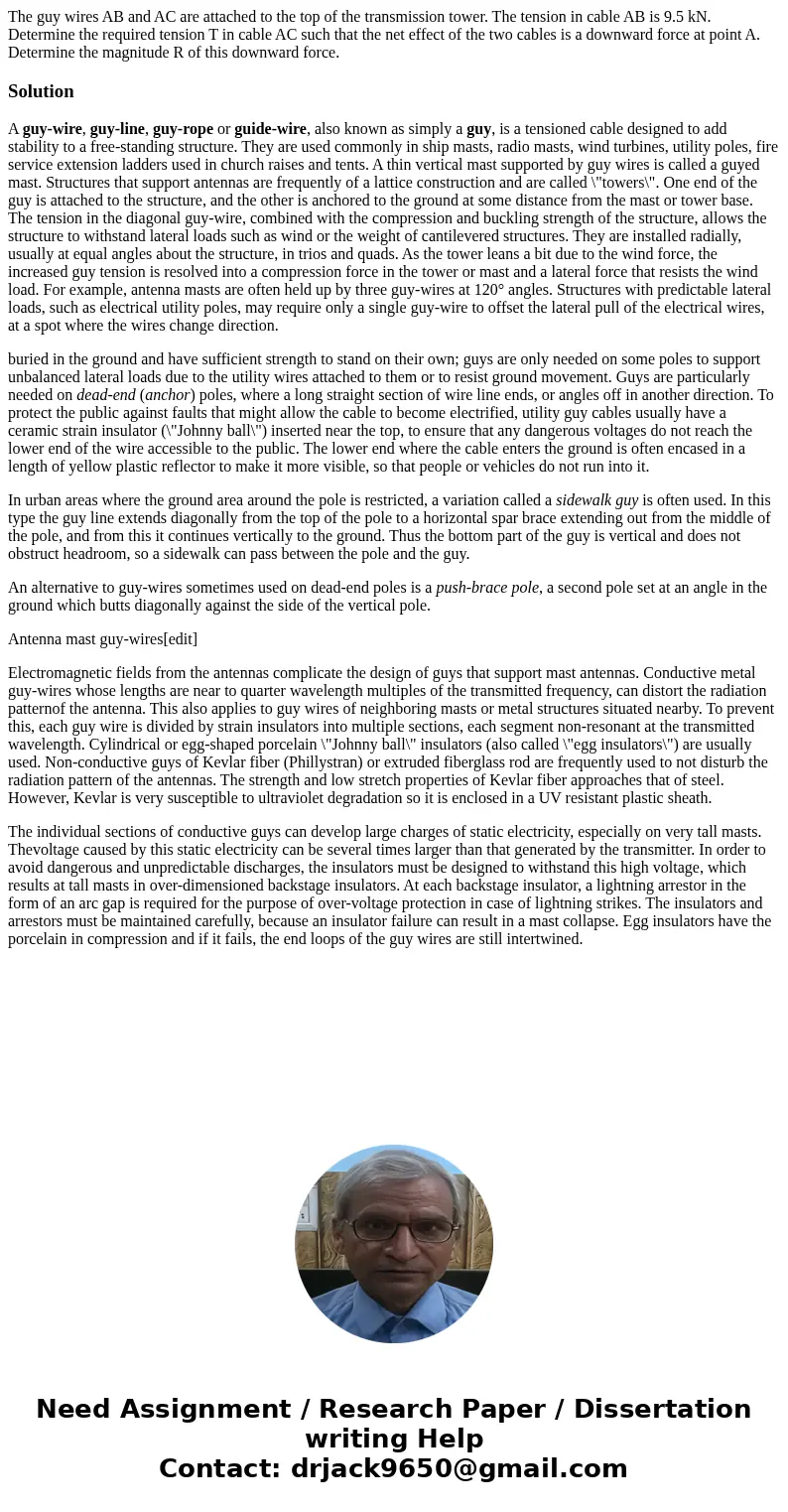The guy wires AB and AC are attached to the top of the trans
Solution
A guy-wire, guy-line, guy-rope or guide-wire, also known as simply a guy, is a tensioned cable designed to add stability to a free-standing structure. They are used commonly in ship masts, radio masts, wind turbines, utility poles, fire service extension ladders used in church raises and tents. A thin vertical mast supported by guy wires is called a guyed mast. Structures that support antennas are frequently of a lattice construction and are called \"towers\". One end of the guy is attached to the structure, and the other is anchored to the ground at some distance from the mast or tower base. The tension in the diagonal guy-wire, combined with the compression and buckling strength of the structure, allows the structure to withstand lateral loads such as wind or the weight of cantilevered structures. They are installed radially, usually at equal angles about the structure, in trios and quads. As the tower leans a bit due to the wind force, the increased guy tension is resolved into a compression force in the tower or mast and a lateral force that resists the wind load. For example, antenna masts are often held up by three guy-wires at 120° angles. Structures with predictable lateral loads, such as electrical utility poles, may require only a single guy-wire to offset the lateral pull of the electrical wires, at a spot where the wires change direction.
buried in the ground and have sufficient strength to stand on their own; guys are only needed on some poles to support unbalanced lateral loads due to the utility wires attached to them or to resist ground movement. Guys are particularly needed on dead-end (anchor) poles, where a long straight section of wire line ends, or angles off in another direction. To protect the public against faults that might allow the cable to become electrified, utility guy cables usually have a ceramic strain insulator (\"Johnny ball\") inserted near the top, to ensure that any dangerous voltages do not reach the lower end of the wire accessible to the public. The lower end where the cable enters the ground is often encased in a length of yellow plastic reflector to make it more visible, so that people or vehicles do not run into it.
In urban areas where the ground area around the pole is restricted, a variation called a sidewalk guy is often used. In this type the guy line extends diagonally from the top of the pole to a horizontal spar brace extending out from the middle of the pole, and from this it continues vertically to the ground. Thus the bottom part of the guy is vertical and does not obstruct headroom, so a sidewalk can pass between the pole and the guy.
An alternative to guy-wires sometimes used on dead-end poles is a push-brace pole, a second pole set at an angle in the ground which butts diagonally against the side of the vertical pole.
Antenna mast guy-wires[edit]
Electromagnetic fields from the antennas complicate the design of guys that support mast antennas. Conductive metal guy-wires whose lengths are near to quarter wavelength multiples of the transmitted frequency, can distort the radiation patternof the antenna. This also applies to guy wires of neighboring masts or metal structures situated nearby. To prevent this, each guy wire is divided by strain insulators into multiple sections, each segment non-resonant at the transmitted wavelength. Cylindrical or egg-shaped porcelain \"Johnny ball\" insulators (also called \"egg insulators\") are usually used. Non-conductive guys of Kevlar fiber (Phillystran) or extruded fiberglass rod are frequently used to not disturb the radiation pattern of the antennas. The strength and low stretch properties of Kevlar fiber approaches that of steel. However, Kevlar is very susceptible to ultraviolet degradation so it is enclosed in a UV resistant plastic sheath.
The individual sections of conductive guys can develop large charges of static electricity, especially on very tall masts. Thevoltage caused by this static electricity can be several times larger than that generated by the transmitter. In order to avoid dangerous and unpredictable discharges, the insulators must be designed to withstand this high voltage, which results at tall masts in over-dimensioned backstage insulators. At each backstage insulator, a lightning arrestor in the form of an arc gap is required for the purpose of over-voltage protection in case of lightning strikes. The insulators and arrestors must be maintained carefully, because an insulator failure can result in a mast collapse. Egg insulators have the porcelain in compression and if it fails, the end loops of the guy wires are still intertwined.

 Homework Sourse
Homework Sourse